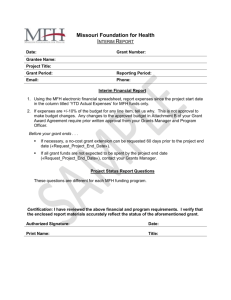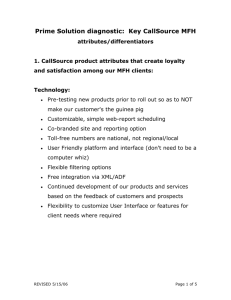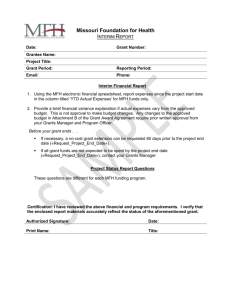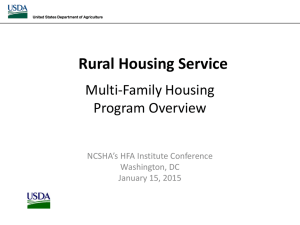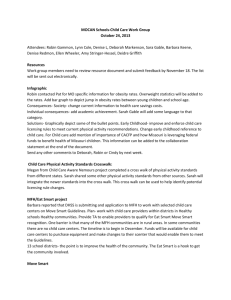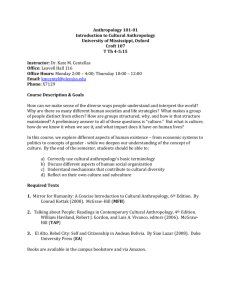Microfinance for Housing: Assisting the “Bottom Billion” and the “Missing Middle”
advertisement
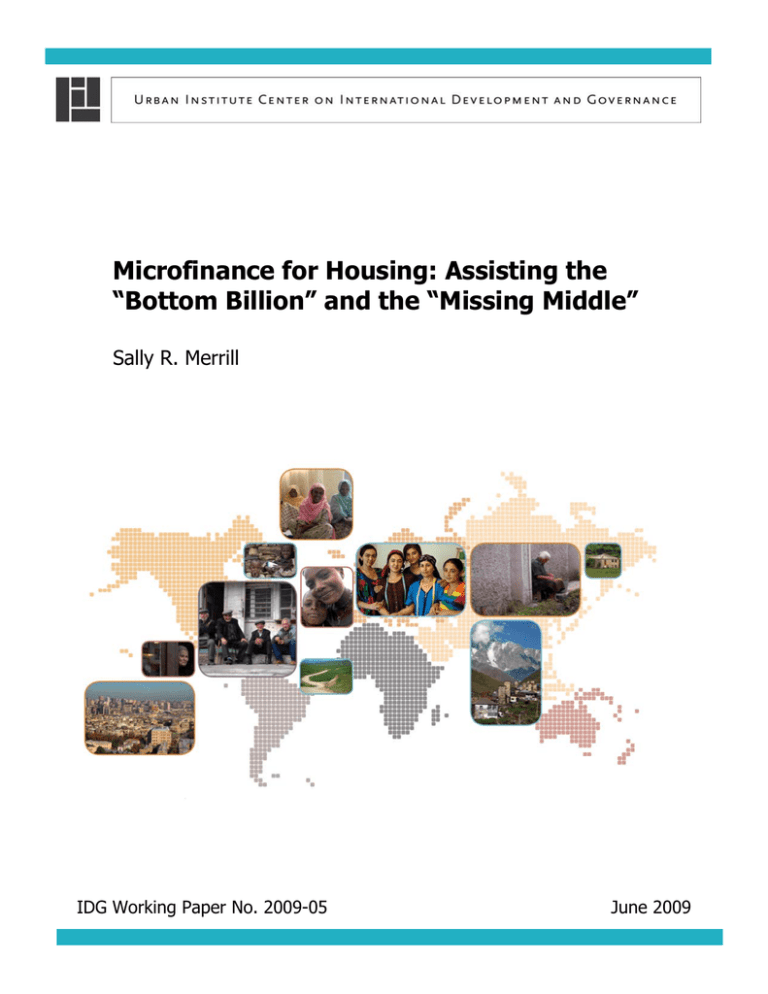
Microfinance for Housing: Assisting the “Bottom Billion” and the “Missing Middle” Sally R. Merrill IDG Working Paper No. 2009-05 June 2009 Microfinance for Housing: Assisting the “Bottom Billion” and the “Missing Middle” Sally R. Merrill June 2009 Abstract UN-HABITAT has calculated that one-sixth of humanity—1 billion people—currently live in slums. In the next 30 years, this figure could rise to over 31 percent of the world’s population. The vast majority of these households will never be able to afford, nor have access to, formal mortgage finance. Thus, increasing the availability of microfinance for housing (MFH) to help provide adequate shelter and sanitation will become increasingly important. Several decades ago, MFH was the nearly invisible stepchild of micro enterprise finance. Micro enterprise loans were indeed used for housing purposes in some cases, but this was not recognized as such, and explicit loan products for MFH did not exist. Change has come rapidly, however, and MFH loan products are now widespread. MFH has two “parents”: microfinance institutions and groups advocating and supporting low income housing. MFH was first strongly entrenched in Latin and Central America, but is now widespread in Asia and also finally taking hold in Africa. The Urban Institute is a nonprofit, nonpartisan policy research and educational organization that examines social, economic, and governance problems. The mission of the Urban Institute Center on International Development and Governance (IDG) is to promote economic and democratic development in developing and transition countries. The views expressed are those of the authors and should not be attributed to the Urban Institute, its trustees, or its funders. IDG Working Paper No. 2009-05 Microfinance for Housing: Assisting the “Bottom Billion” and the “Missing Middle” Sally R. Merrill June 2009 1. What is MFH? Microfinance for housing (MFH) is a subset of microfinance, designed to meet the housing needs of the poor, especially those without access to the banking sector or formal mortgage loans. MFH is designed for low-income households who wish to expand or improve their dwellings, or to build a home in incremental steps, relying on sequential small loans. MFH differs from formal mortgage lending in four key ways: • • • • the loans are smaller and shorter term than conventional mortgage loans, because of their smaller size, MFH loans are not used to purchase a home but rather for home improvements, incremental building, or development of a starter dwelling in sites and services initiatives; MFH loans are usually not collateralized by the property, which is, of course, a defining characteristic of formal mortgage loans; and Whereas banks are the primary source of mortgage lending, MFH is offered by MFIs, NGOs, co-ops and NBFIs. MFH clients generally cannot qualify for formal mortgage loans for a variety of reasons, including low income, informal sources of income, lack of land title, and inability to meet formal building standards (standards which are often far too rigid for accommodate affordable housing).. 2. How does MFH differ from Micro-enterprise Finance? Micro-enterprise finance (MEF) provides working capital and fixed assets loans to micro entrepreneurs. Underwriting of MEF is generally based on assessment of ability to pay (an income stream, cash flow from the enterprise being funded) and assumed willingness to pay (prior successful MEF loan, character assessment). Business equipment and various assets, including property, are often used as collateral. MFH loans, in contrast, are specifically targeted to housing development or improvement. In some cases previous success with micro-enterprise loans is used to underwrite MFH loans. However, as not all MFH borrowers may be entrepreneurs, and not all MFH loans are offered by micro lenders, underwriting generally includes a variety of approaches to reducing credit risk. Lenders may rely on mandatory savings IDG Working Paper No. 2009-05 2 over a specified period, membership in savings groups, and/or co-signers. A number of MFIs, particularly, in South Africa, have relied on payroll deduction for those formally employed. Similarly, collateral may include property and other assets not linked to a micro enterprise; land title is required by some but not all MFH lenders. It should be noted, however, that MFH and MEF loans may sometimes be indistinguishable: many micro businesses are conducted in whole or in part from the home, and many micro lenders have learned that some portion of their loans are being used for housing. Thus, MFH may in fact expand or improve the households dwelling for the purpose of conducting its business, or selling or storing the goods being produced. In addition, expanding the dwelling by building a shop in front of the home or adding extra rooms for rental purposes, and thus producing an income stream, also emphasize the numerous links between MFH and MEF. Table 1: Loan Features and Underwriting Requirements Loan Feature /Institution Loan Size Maximum Term Security Savings Required? Linked or Stand Alone Time with Organization Genderbased? Land Ownership Housing Technical Assistance SEWA Bank $333 average; $4,444 max 120 months Grameen Bank CARD ADEMI FUNH AVI Kuyasa Fund ACCION Latin America $300 to $3,500 $100 $600 $359 $4,000 $3,000 $700 12 months 5 cosigners Yes 36 months 1 yr savings; 2 co-signers Yes 120 months 5 cosigners Yes 20 months 2 cosignors No 24 months 6 months savings Yes 120 months Mostly cosigner No Linked Linked Linked Stand alone Stand alone Stand alone 1 year minimum Women only 2 years minimum Mostly women required 1.5 years Not required Mostly women required No no Not required Mostly not No No No Not required Yes Stand alone Not required Mostly women Required No Mostly not Not required Assistance for Illiteracy Collateralized No Not required No Sources: Merrill and Mesarina (2006); Daphnis and Ferguson (2004); Merrill and Wambugu (2007); Escobar and Merrill (2004) As illustrated in Table 1, there is great variability in MFH loan features: amount, term, collateral, and so forth. Home improvement loans are typically short- to mid-term loans from three months to 36 months. However, some MFIs offer a wider range of terms—up to 60 months or more. In some cases, MFH loans are somewhat larger as well as longer duration than MEF loans; SEWA and Grameen, for example, offer up to 10-year loans but the typical loan is generally of shorter IDG Working Paper No. 2009-05 3 duration. However, as MFH pushes into a mini-mortgage market, as discussed below, this distinction will become more pronounced. Interest rates are in some cases below those for working capital loans and vary greatly from one market to another. Fixed interest rates are the most common, although BancoSol in Ecuador has diversified its housing loan products to include a variable rate product for loans with terms of 36 months or more. 3. Who Offers MFH? MFH is offered by a wide variety of institutions worldwide, including MFIs, banks, NBFIs, cooperatives, credit unions, and NGOs. A major distinction can be made between financial institutions offering micro enterprise loans (MFIs, banks and NBFIs), and institutions whose main purpose is improving the shelter situation of the poor, which may or may not be financial institutions. Table 2 provides just a few examples from the worldwide distribution network. The MFI group includes BRI, Grameen, and SEWA, the ACCION network in Latin America, UML, CARD, K-Rep and Jamii Bora. In addition, PRIDE and Finca, MFIs with large worldwide networks, are increasingly introducing MFH products. Table 2: Examples of Institutions Providing Microfinance for Housing Latin America and Central America Mibanco (Peru) Bank Banco Solidario (Ecuador) Bank Integral (El Salvador) Bank BancoSol (Bolivia) Bank Finamerica (Colombia) NBFI Sogesol (Haiti) MFI FAMA (Nicaragua) Transforming to a bank El Comercio (Paraguay) Fundacion (Santo Domingo) Compartamos (Mexico) Asia and Africa SEWA Bank (India) Cooperative Bank SPARC (India) NGO Grameen (Bangladesh) Specialized Bank PRIDE (worldwide) MFI BRI (Indonesia) Large MFI UML (Uganda) MFI Kuyasa (South Africa) NBFI CARD (Philippines) Bank Jamii Bora (Kenya) Foundation Financial institution MFI NACHU (Kenya) Apex for Housing Coops Bank Finca (worldwide) MFI The second group of institutions, whose primary focus is improving shelter, are NGOs or NBFIs that have evolved from housing NGOs as financial institutions; examples from this group includes Kuyasa, SPARC, and NACHU’S housing cooperative members. Finally, several network NGOs provide low income housing solutions, including Habitat for Humanity and CHF International. IDG Working Paper No. 2009-05 4 4. Why is MFH Important? Micro enterprise finance has come increasingly into mainstream finance, given its rapid growth and newly-forged links with the banking sector and capital market. There is also a current focus on the world’s poorest people: the so-called “bottom billion”.1 At the same time, the tremendous growth in urban populations worldwide and the huge proportion of this urban population living in slums and/or without proper shelter and sanitation have been vividly described. The United Nations World Urban Forums (WUF), for example, in Vancouver (2006) and Beijing (2008), have alerted the world to the dilemmas of the urbanizing poor. It is increasingly recognized, especially in the lower income emerging markets, that the vast majority of households now have no choice but to build their own housing and to finance it from own savings—a slow and laborious process. In these markets, there are often many barriers to expanding formal mortgage finance, including a poor macroeconomic environment, an inadequate legal framework, and numerous supply-side constraints, all combined with very limited affordability. Thus, lack of appropriate loan products for down-market lending robs these households of realizing their housing goals in any reasonable time frame. House construction can take decades and in many cases generations. This, in turn, not only robs household of realizing better shelter, but also the economy of the major developmental stimulus that housing is known to provide. MFH is certainly no panacea, but can be one important tool in providing affordable housing. Also, the uses and contexts for MFH are now changing in major ways—both up and down the income distribution. The profile of MFH borrowers has previously been similar to that for mainstream MEF clients: modest and lower income but generally not the destitute. However, housing assistance to the bottom billion—the very poor—now also takes place in the context of slum upgrading, as advocates seek the most effective financial models for addressing this blight.2 Even in subsidized housing development projects, MFH is useful not only for the contribution that the poor can make to their housing but also for engendering a sense of ownership and community via savings groups. SPARC, as one example, has long championed developing partnerships among lenders, donors, government, and slum dwellers to address infrastructure and sanitation as well as low cost housing. When slum upgrading also involves multistory housing, the complication of funding must also be addressed, as construction finance is likely to be in short supply, and/or those construction companies willing to built low-cost housing do not have sufficient capital to warrant a bank loan. MFH loan products are also being modified to move up the income scale. Numerous middle and low-middle income households in emerging markets, many eminently bankable, have been below the purview of both banks offering formal mortgage loans and builders providing modest, affordable housing. This is the so-called “missing middle”—households that could service a mortgage loan of modest size and medium duration (e.g., 7 to 15 years rather than the typical 20 1 See Paul Collier, The Bottom Billion. Also, the award of the Nobel Peace Prize for Peace to Mohammed Yunis, founder of Grameen Bank in Bangladesh, has had a catalyzing effect. 2 There are an increasing number of efforts underway on slum upgrading. Brazil, Morocco, Thailand, and India are among the countries undertaking major projects. Numerous donors, UN-HABITAT’s SUF (Slum Upgrading Facility) and the Cities Alliance are examples of organizations involved in slum upgrading. IDG Working Paper No. 2009-05 5 or more) but have had no opportunity to borrow. Whether such loans are dubbed “minimortgages” or large MFH loans, demonstration efforts to better underwrite such households are underway. The wide income diversity of slums is also being recognized, as slums are often home to educated and fairly well-to-do households. Recent efforts have sought to bring banks into this context, either as lenders or MFI partners. In India, the FIRST Initiative has been sponsoring initiatives to link lenders providing mortgages to modest income households with developers willing to build housing that these groups can afford. USAID, working with the National Housing Bank and a very forward-looking institution—ICICI Bank—investigated partnerships involving MFH and credit enhancements to kick-start more mini-mortgage lending (Monitor Group 2006; Merrill and Suri 2007). 5. Funding MFH Table 3 illustrates typical funding sources for various lenders that offer MFH. Institutions that are registered as banks can rely on demand deposits, while NBFIs seek savings accounts. The table also illustrates another distinction that can be made among institutions offering MFH: (1) microfinance institutions that fund themselves on strictly commercial terms, at market rates, and (2) those that are also subsidized through various combinations of grants, donor, and government funds. Many large MFIs, such as BRI and the ACCION network in Latin America, are financially sustainable. For this group, lines of credit from commercial banks or capital market institutions are increasingly important. PRIDE Tanzania receives credit from the National Microfinance Bank and Azania Bancorp, In contrast, the Kuyasa Fund and SEWA Bank , and major NGOs such as SPARC in India and Jamii Bora in Kenya, continue to receive subsidies from donors and foundations. Commercial borrowing may be facilitated by credit enhancements. Table 3: Funding Sources for Institutions Offering MFH X X X X FAMA X Kuyasa X X NACHU X Mibanco X X X X X X X X X X Grameen Bank X BRI X CARD Bank Deposits Commercial Credit Donor Funds Foundation Funds Public Funds International Finance Corp. Credit Enhancement SPARC Mandatory Savings SEWA Bank Banco Sol Type of Funding X X X X X X X X X X X X IDG Working Paper No. 2009-05 X 6 Subsidy funding may take the form of infusions of capital or funds to increase liquidity. K-Rep, in Kenya, specializes in construction finance for low income housing; its shareholders include the IFC, Shorebank, the African Development Bank and two commercial banks based in the Netherlands. Many shelter-focused institutions receive donor assistance in order to provide more affordable products. Kuyasa's funds include a line of credit from a major Pan-African Bank, which is guaranteed by a credit enhancement. SPARC’s funds from CLIFF provided critical bridge financing, paving the way for SPARC’s construction finance loan from India’s ICICI bank. Jamii Bora receives much of its funding from NGOs and church affiliations in Scandinavia. NACHU has received major funding from Rooftops Canada, among others. 6. Demand and Supply for MFH Although no worldwide estimate has ever been made, the potential demand for MFH is assumed to be large, based on both MFI opinion and customer surveys. A survey of selected MFH lenders was made in 2005-2006, and the results of shown in Table 4. Although these figures have most likely been far surpassed by now, no systematic survey has been recently undertaken. It is illustrative to look at the recent record of ACCION’s network in Latin America, which achieved notable growth as the housing portfolio jumped from US$38 million in December 2002 to US$117 million in December 2005. The growth experience of some individual MFIs is also instructive. Mibanco and BancoSol have continued to experience significant growth in MFH; BancoSol’s 2005 housing portfolio reached 35 percent of its total and Mibanco’s reached more than 15 percent. SEWA Bank’s housing loans grew by 55 percent in 2005. Table 4: Micro Institution Portfolios and Micro Housing Loans: 2005–2006 Institution Total portfolio, 2005 ($) Total housing ($) Housing loans as a percent of the total portfolio Percentage of home improvement loans in housing portfolio 624,324,129 116,784,223 18.7 62 1,340,000,000 116,784,223 8.7 60 Mibanco 206,729,374 30,864,706 20 50 BancoSol 130,106,032 45,083,923 35 50 5,415,555 1,638,812 27 80 8,572,000,000 85,300,000 1 N/A 11,325,566 2,900,000 1,223,204 2,970,000 10.8 100 N/A 50 ACCION Network offering MFH ACCION total Network SEWA BRI UML Kuyasa Fund Source: Merrill and Mesarina 2006 IDG Working Paper No. 2009-05 7 In sum, efforts are now needed to gain a better understanding of MFH portfolios worldwide. The evidence suggests the following: (1) MFH is growing fairly rapidly; (2) the number of institutions offering MFI is growing worldwide, especially in Africa and Asia (as MFH is already more established in Latin America); (3) MFH still represents only a limited portion of MFI total portfolios. Why do various institutions offer MFH? For MFIs, customer demand and cross-selling have been important factors. Grameen Bank in Bangladesh, for example, recognized customer demand for MFH some years ago, and began offering housing loans as “rewards” for successful completion of micro enterprise loans. Grameen recognized the emotional attachment that customers have to their homes as both the family’s shelter and their key asset. On the other hand, some MFIs may be unwilling to provide major funding or MFH at the expense of their traditional micro-enterprise lending; thus, increasing liquidity to low income lenders is crucial. 7. Challenges to Microfinance and MFH MFH faces many of the same types of barriers that constrain micro-enterprise lending from reaching the scale and efficiency that its proponents hope to achieve. In addition, if being offered an MFH loan is dependent on cash flow from micro-enterprise, the situation becomes more complex. The impact of microfinance on income generation is a widely-debated topic. Does microfinance improve the livelihood of the poor? Is the impact on the productivity of the poor sufficient to sustain a real increase in income? Is this the case at high interest rates? Table 5: Challenges and Potential Solutions Barriers to MFH Development Potential Policies to Address Barriers Problems facing Individual Lenders Lack of knowledge of MFH loan products Technical Assistance for loan products Limited capacity to manage funds Capacity building/management training Shelter NGOs lacking financial expertise Development of finance subsidiary Financial Sector and Capital Market Barriers Limited liquidity banks and capital markets Strengthen financial sector Term mismatch: limited access long-term funds Develop liquidity facilities Limited bank/MFI/capital market linkages Utilize credit enhancement to kick-start linkages Weak regulatory framework/no credit bureau Improve regulatory and legal frameworks Shelter Sector Barriers Lack of tenure security and secure land titles Land reforms and land titling Lack of infrastructure development Use of govt./ donor funds for infrastructure Lack of land use planning and slum upgrading Also a priority for govt./donor funds Unrealistically high building standards Develop standards for affordable housing MFH faces three distinct types of barriers: • • Decisions taken concerning focus and trade-offs among loan products by micro lenders Financial and capital market barriers facing all micro-lenders, but there are some additional complications for MFH IDG Working Paper No. 2009-05 8 • Shelter sector barriers, such as lack of land and infrastructure, unique to MFH, and perhaps the most crucial barrier for reaching scale and effectiveness A major debate which continues to divide the MFI community concerns the pros and cons of obtaining commercial funding at market rates vs. subsidized funds to provide more affordable interest rates. Indeed, when Muhammad Yunus received the Nobel Peace Prize, the award led to much greater awareness of the microfinance sector, as noted. But it also sparked more debate about the virtues and drawbacks of “for-profit” commercial micro-lenders and those who seek to improve affordability by utilizing grant funds or funds obtained at below market cost.3 For example, does commercialization lead to mission creep? Does commercialization increase defaults because of higher rates? Related funding issues include the cost and availability of funds for on-lending via commercial bank linkages; fixed versus variable rate loan products (low income borrowers prefer fixed rate loans, but interest rate risk may be an issue); and external borrowing and the consequent foreign exchange risk. Term match is also an issue, as MFH loans are ideally somewhat longer than typical micro-enterprise loans. Other issues of importance to MFH borrowers stem from housing market concerns impacting mortgage borrowers and MFH clients alike, including the availability of land and the security of land title. Tenure security is an issue of both collateral for the lender and an indicator of the willingness of the borrower to repay and invest in the property. Donor and government subsidy funds available for housing development, especially in low income emerging markets, could be spent more wisely in order to help the greatest number of households obtain access to sanitary living conditions. With a limited budget it may be wise to decrease subsidies on housing construction or subsidized loans and increase support to land, land titling, and infrastructure. Housing subsidies sufficient to build housing of high standards for low income households is often ineffective: if the middle class has also not had sufficient access to housing, they usurp the heavily subsidized projects done for the poor. This so-called “rent seeking” behavior results in higher income households simply buying out the lower income groups that the housing program was designed to assist, while the targeted households once again begin the slum process. 8. Conclusions What role can MFH play in the difficult environment of rapid urbanization and growth of slums? Lack of appropriate loan products for down-market lending robs households of realizing their housing goals in any reasonable time frame. But better loan products, by themselves, are necessary but not sufficient if the result is unplanned development which robs households of fully realizing the collateral they have put into their housing. Table 6 seeks to summarize the key issues and challenges of MFH. It is now widely accepted that the private financial sector, including the MFI industry, should play a bigger role in housing provision. Table 6 notes four 3 As an example, after much discussion among staff and members, NACHU has taken the decisions to seek bank funding at commercial rates. See Merrill, NACHU IDG Working Paper No. 2009-05 9 illustrative income groups, and the relevant type of MFH loan product for each; the loan terms and the likely lenders for each type are also noted. Similarly, the affordability profile of the borrowers needs to be matched with relevant types of housing. Table 6: MFH Products for Different Income Groups and House Types MFH, Subsidy, and TA Features Moderate Income Lender Loan product Loan term Loan Products and Lenders Bank, MFI Bank, MFI Bank MFI, NGO Mini- Mortgage Mortgage or MFH MFH 7-12 years 5-7 years or 3-5 years and/or incremental incremental Interest rate Underwriting Collateral Developer/builder House Design TA-loan product design TA-house design TA-market survey TA—infrastructure Modest Income Market + 1% Salary + informal income: previous MEF loan; payroll deduction Land, other assets Market + 3% Salary + informal income; previous MEF loan, savings Probably land; savings required? Construction Established Established developer developer Modest standard Starter home or dwelling incremental Technical Assistance Loan design, Loan design, underwriting underwriting; savings product Modest dwelling Starter home Yes Yes Revenue bonds Revenue bonds Interest Rate Subsidy Land: public provision Infrastructure: public provision Construction finance subsidy None Source of liquidity Low –Modest Income Low Income MFI, NGO MFH 2-3 years and/or incremental Market + 5% Informal income; previous MEF loan, savings Market + 5-10% Informal income; previous MEF loan; savings Possibly land; savings required? Savings required? Construction firm Construction firm, cooperatives Incremental or sites and services Incremental Loan design, Underwriting; savings product Incremental No (need public provision) Subsidy Requirements None None Loan design, Underwriting; savings products Incremental No (need public provision) None None Probable Prefer to have none Probable None Possibly Yes Yes None None None Perhaps necessary Long-run goal: Liquidity Facility; pension + capital market reforms Liquidity Issues Long-run goal: Liquidity Facility; pension + capital market reforms IDG Working Paper No. 2009-05 Microfinance Credit Enhancement Facility Assistance from Microfinance Enhancement Facility 10 Technical assistance can be helpful in many ways. Where appropriate, government subsidies can greatly assist, but only if provided in a manner that does not conflict with the financial incentives. For example, deep interest rate subsidies run counter to attempts to source commercial funding at scale; mixed commercial/donor funding sources can lower rates to some extent. Similarly, credit enhancement programs are useful if used appropriately; if not, they can backfire and result in mass delinquencies. In sum, MFH is hardly a panacea, especially for lower income groups. Foremost there is the problem of reaching meaningful scale. Second, MFH needs to be built into a context where its usefulness can be maximized: major synergies can emerge when MFH is combined with secure title and infrastructure, which maximize household incentives to save and to borrow. IDG Working Paper No. 2009-05 11 References Collier, Paul. 2007. The Bottom Billion: Why the Poorest Countries are Failing and What Can Be Done about It. Oxford University Press. Finmark Trust, Rooftops Canada, Habitat for Humanity. 2008. “Growing Sustainable Housing Microfinance Options in Sub-Saharan Africa: Enhancing the Relevance and Scale of Housing for the Poor.” Workshop Report. Daphnis, Franck, and Bruce Ferguson. 2004. Housing Microfinance: A Guide to Practice. Bloomfield, CT: Kumerian Press. Escobar, Alejandro, and Sally Merrill. 2004. “Housing Microfinance: The State of the Practice.” Housing Microfinance: A Guide to Practice, edited by Franck Daphnis and Bruce Ferguson. Bloomfield, CT: Kumerian Press. GHK. 2006. “Independent Evaluation of the Community Led Infrastructure Finance Facility, for Cities Alliance: Cities Without Slums.” Merrill, Sally, and Angela Wambugu. 2007. “Housing for the Poor in Kenya: NACHU’s Cooperative Approach.” USAID: USAID MicroNote. Merrill, Sally, and Nino Mesarina. 2006. “Microfinance for Housing.” USAID: USAID MicroNote. Merrill, Sally, and Ajay Suri. 2007. “Low Income Shelter Finance in Slum Upgrading: India Urban Initiatives.” Washington, DC: The Urban Institute. Mesarina, Nino, and Christy Stickney. 2007. “Getting to Scale in Housing Microfinance: A Study of ACCION Partners in Latin America.” ACCION. Monitor Group. 2006. “Expanding the Housing Market to Cover Un-served Segments in Urban and Rural India, for the FIRST Initiative”. Shorebank International. 2008. “Global Financial Innovations Partnership, Shorebank International.” SINA, Settlements Information Network Africa, Newsletter February 2007 IDG Working Paper No. 2009-05 12
